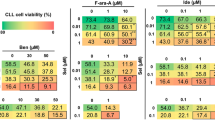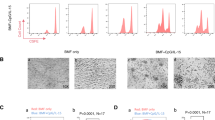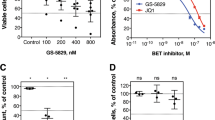Abstract
Chronic lymphocytic leukemia (CLL) cells located in proliferation centers are constantly stimulated by accessory cells, which provide them with survival and proliferative signals and mediate chemotherapy resistance. Herein, we designed an experimental strategy with the aim of mimicking the microenvironment found in the proliferative centers to specifically target actively proliferating CLL cells. For this, we co-cultured CLL cells and bone marrow stromal cells with concomitant CD40 and Toll-like receptor 9 stimulation. This co-culture system induced proliferation, cell-cycle entry and marked resistance to treatment with fludarabine and bendamustine. Proliferating CLL cells clustered together showed a typical morphology of activated B cells and expressed survivin protein, a member of the inhibitor of apoptosis family that is mainly expressed by CLL cells in the proliferation centers. With the aim of specifically targeting actively proliferating and chemoresistant CLL cells, we investigated the effects of treatment with YM155, a small-molecule survivin inhibitor. YM155 treatment suppressed the co-culture-induced survivin expression and that was sufficient to inhibit proliferation and effectively induce apoptosis particularly in the proliferative subset of CLL cells. Interestingly, sensitivity to YM155 was independent from common prognostic markers, including 17p13.1 deletion. Altogether, these findings provide a rationale for clinical development of YM155 in CLL.
This is a preview of subscription content, access via your institution
Access options
Subscribe to this journal
Receive 12 print issues and online access
$259.00 per year
only $21.58 per issue
Buy this article
- Purchase on Springer Link
- Instant access to full article PDF
Prices may be subject to local taxes which are calculated during checkout





Similar content being viewed by others
References
Caligaris-Cappio F, Hamblin TJ . B-cell chronic lymphocytic leukemia: a bird of a different feather. J Clin Oncol 1999; 17: 399–408.
Dameshek W . Chronic lymphocytic leukemia–an accumulative disease of immunolgically incompetent lymphocytes. Blood 1967; 29 (Suppl): 566–584.
Messmer BT, Messmer D, Allen SL, Kolitz JE, Kudalkar P, Cesar D et al. In vivo measurements document the dynamic cellular kinetics of chronic lymphocytic leukemia B cells. J Clin Invest 2005; 115: 755–764.
Herishanu Y, Pérez-Galán P, Liu D, Biancotto A, Pittaluga S, Vire B et al. The lymph node microenvironment promotes B-cell receptor signaling, NF-kappaB activation, and tumor proliferation in chronic lymphocytic leukemia. Blood 2011; 117: 563–574.
Giné E, Martinez A, Villamor N, López-Guillermo A, Camos M, Martinez D et al. Expanded and highly active proliferation centers identify a histological subtype of chronic lymphocytic leukemia (“accelerated” chronic lymphocytic leukemia) with aggressive clinical behavior. Haematologica 2010; 95: 1526–1533.
Burger JA, Tsukada N, Burger M, Zvaifler NJ, Dell’Aquila M, Kipps TJ . Blood-derived nurse-like cells protect chronic lymphocytic leukemia B cells from spontaneous apoptosis through stromal cell-derived factor-1. Blood 2000; 96: 2655–2663.
Pedersen IM, Kitada S, Leoni LM, Zapata JM, Karras JG, Tsukada N et al. Protection of CLL B cells by a follicular dendritic cell line is dependent on induction of Mcl-1. Blood 2002; 100: 1795–1801.
Lagneaux L, Delforge A, Bron D, De Bruyn C, Stryckmans P . Chronic lymphocytic leukemic B cells but not normal B cells are rescued from apoptosis by contact with normal bone marrow stromal cells. Blood 1998; 91: 2387–2396.
Granziero L, Ghia P, Circosta P, Gottardi D, Strola G, Geuna M et al. Survivin is expressed on CD40 stimulation and interfaces proliferation and apoptosis in B-cell chronic lymphocytic leukemia. Blood 2001; 97: 2777–2783.
Ghia P, Strola G, Granziero L, Geuna M, Guida G, Sallusto F et al. Chronic lymphocytic leukemia B cells are endowed with the capacity to attract CD4+, CD40L+ T cells by producing CCL22. Eur J Immunol 2002; 32: 1403–1413.
Bagnara D, Kaufman MS, Calissano C, Marsilio S, Patten PEM, Simone R et al. A novel adoptive transfer model of chronic lymphocytic leukemia suggests a key role for T lymphocytes in the disease. Blood 2011; 117: 5463–5472.
Kurtova AV, Balakrishnan K, Chen R, Ding W, Schnabl S, Quiroga MP et al. Diverse marrow stromal cells protect CLL cells from spontaneous and drug-induced apoptosis: development of a reliable and reproducible system to assess stromal cell adhesion-mediated drug resistance. Blood 2009; 114: 4441–4450.
Meads MB, Hazlehurst LA, Dalton WS . The bone marrow microenvironment as a tumor sanctuary and contributor to drug resistance. Clin Cancer Res 2008; 14: 2519–2526.
Böttcher S, Ritgen M, Fischer K, Stilgenbauer S, Busch RM, Fingerle-Rowson G et al. Minimal residual disease quantification is an independent predictor of progression-free and overall survival in chronic lymphocytic leukemia: a multivariate analysis from the randomized GCLLSG CLL8 trial. J Clin Oncol 2012; 30: 980–988.
Pascutti MF, Jak M, Tromp JM, Derks IAM, Remmerswaal EBM, Thijssen R et al. IL-21 and CD40L signals from autologous T cells can induce antigen-independent proliferation of CLL cells. Blood 2013; 122: 3010–3019.
Tretter T, Schuler M, Schneller F, Brass U, Esswein M, Aman MJ et al. Direct cellular interaction with activated CD4(+) T cells overcomes hyporesponsiveness of B-cell chronic lymphocytic leukemia in vitro. Cell Immunol 1998; 189: 41–50.
Willimott S, Baou M, Naresh K, Wagner SD . CD154 induces a switch in pro-survival Bcl-2 family members in chronic lymphocytic leukaemia. Br J Haematol 2007; 138: 721–732.
Scielzo C, Apollonio B, Scarfò L, Janus A, Muzio M, Ten Hacken E et al. The functional in vitro response to CD40 ligation reflects a different clinical outcome in patients with chronic lymphocytic leukemia. Leukemia 2011; 25: 1760–1767.
Tromp JM, Tonino SH, Elias JA, Jaspers A, Luijks DM, Kater AP et al. Dichotomy in NF-kappaB signaling and chemoresistance in immunoglobulin variable heavy-chain-mutated versus unmutated CLL cells upon CD40/TLR9 triggering. Oncogene 2010; 29: 5071–5082.
Jahrsdörfer B, Hartmann G, Racila E, Jackson W, Mühlenhoff L, Meinhardt G et al. CpG DNA increases primary malignant B cell expression of costimulatory molecules and target antigens. J Leukoc Biol 2001; 69: 81–88.
Decker T, Schneller F, Sparwasser T, Tretter T, Lipford GB, Wagner H et al. Immunostimulatory CpG-oligonucleotides cause proliferation, cytokine production, and an immunogenic phenotype in chronic lymphocytic leukemia B cells. Blood 2000; 95: 999–1006.
Fonte E, Apollonio B, Scarfò L, Ranghetti P, Fazi C, Ghia P et al. In vitro sensitivity of CLL cells to fludarabine may be modulated by the stimulation of Toll-like receptors. Clin Cancer Res 2013; 19: 367–379.
Altieri DC . The case for survivin as a regulator of microtubule dynamics and cell-death decisions. Curr Opin Cell Biol 2006; 18: 609–615.
Ambrosini G, Adida C, Altieri DC . A novel anti-apoptosis gene, survivin, expressed in cancer and lymphoma. Nat Med 1997; 3: 917–921.
Marusawa H, Matsuzawa S-I, Welsh K, Zou H, Armstrong R, Tamm I et al. HBXIP functions as a cofactor of survivin in apoptosis suppression. EMBO J 2003; 22: 2729–2740.
Altieri DC . Molecular circuits of apoptosis regulation and cell division control: the survivin paradigm. J Cell Biochem 2004; 92: 656–663.
Nakagawa Y, Yamaguchi S, Hasegawa M, Nemoto T, Inoue M, Suzuki K et al. Differential expression of survivin in bone marrow cells from patients with acute lymphocytic leukemia and chronic lymphocytic leukemia. Leuk Res 2004; 28: 487–494.
Sachanas S, Levidou G, Angelopoulou MK, Moschogiannis M, Yiakoumis X, Kalpadakis C et al. Apoptotic and proliferative characteristics of proliferation centers in lymph node sections of patients with chronic lymphocytic leukemia. Leuk Lymphoma 2013.
Grzybowska-Izydorczyk O, Cebula B, Robak T, Smolewski P . Expression and prognostic significance of the inhibitor of apoptosis protein (IAP) family and its antagonists in chronic lymphocytic leukaemia. Eur J Cancer 2010; 46: 800–810.
Nakahara T, Kita A, Yamanaka K, Mori M, Amino N, Takeuchi M et al. Broad spectrum and potent antitumor activities of YM155, a novel small-molecule survivin suppressant, in a wide variety of human cancer cell lines and xenograft models. Cancer Sci 2011; 102: 614–621.
Tang H, Shao H, Yu C, Hou J . Mcl-1 downregulation by YM155 contributes to its synergistic anti-tumor activities with ABT-263. Biochem Pharmacol 2011; 82: 1066–1072.
Nakahara T, Takeuchi M, Kinoyama I, Minematsu T, Shirasuna K, Matsuhisa A et al. YM155, a novel small-molecule survivin suppressant, induces regression of established human hormone-refractory prostate tumor xenografts. Cancer Res 2007; 67: 8014–8021.
Tyner JW, Jemal AM, Thayer M, Druker BJ, Chang BH . Targeting survivin and p53 in pediatric acute lymphoblastic leukemia. Leukemia 2012; 26: 623–632.
Feng W, Yoshida A, Ueda T . YM155 induces caspase-8 dependent apoptosis through downregulation of survivin and Mcl-1 in human leukemia cells. Biochem Biophys Res Commun 2013; 435: 52–57.
Kaneko N, Kita A, Yamanaka K, Mori M . Combination of YM155, a survivin suppressant with a STAT3 inhibitor: a new strategy to treat diffuse large B-cell lymphoma. Leuk Res 2013; 37: 1156–1161.
Chen J, Pise-Masison CA, Shih JH, Morris JC, Janik JE, Conlon KC et al. Markedly additive antitumor activity with the combination of a selective survivin suppressant YM155 and alemtuzumab in adult T-cell leukemia. Blood 2013; 121: 2029–2037.
Kita A, Mitsuoka K, Kaneko N, Nakata M, Yamanaka K, Jitsuoka M et al. Sepantronium bromide (YM155) enhances response of human B-cell non-Hodgkin lymphoma to rituximab. J Pharmacol Exp Ther 2012; 343: 178–183.
Cheson BD, Bartlett NL, Vose JM, Lopez-Hernandez A, Seiz AL, Keating AT et al. A phase II study of the survivin suppressant YM155 in patients with refractory diffuse large B-cell lymphoma. Cancer 2012; 118: 3128–3134.
Papadopoulos KP, Smith SE, Steinberg J, Papa R, Lopez-Jimenez J, Keating A et al. A phase II study of sepantronium bromide (YM155) plus rituximab in previously treated subjects with aggressive CD20-positive B cell non-Hodgkin’s lymphoma who are ineligible for or have previously received an autologous stem cell transplant. Stage I results. Blood 2012; 120, abstract 2731.
Tolcher AW, Quinn DI, Ferrari A, Ahmann F, Giaccone G, Drake T et al. A phase II study of YM155, a novel small-molecule suppressor of survivin, in castration-resistant taxane-pretreated prostate cancer. Ann Oncol 2012; 23: 968–973.
Kelly RJ, Thomas A, Rajan A, Chun G, Lopez-Chavez A, Szabo E et al. A phase I/II study of sepantronium bromide (YM155, survivin suppressor) with paclitaxel and carboplatin in patients with advanced non-small-cell lung cancer. Ann Oncol 2013; 24: 2601–2606.
Calissano C, Damle RN, Marsilio S, Yan X-J, Yancopoulos S, Hayes G et al. Intraclonal complexity in chronic lymphocytic leukemia: fractions enriched in recently born/divided and older/quiescent cells. Mol Med 2011; 17: 1374–1382.
Chou T-C . Drug combination studies and their synergy quantification using the Chou-Talalay method. Cancer Res 2010; 70: 440–446.
MacPhail SH, Banáth JP, Yu TY, Chu EHM, Lambur H, Olive PL . Expression of phosphorylated histone H2AX in cultured cell lines following exposure to X-rays. Int J Radiat Biol 2003; 79: 351–358.
Longo PG, Laurenti L, Gobessi S, Petlickovski A, Pelosi M, Chiusolo P et al. The Akt signaling pathway determines the different proliferative capacity of chronic lymphocytic leukemia B-cells from patients with progressive and stable disease. Leukemia 2007; 21: 110–120.
Glaros TG, Stockwin LH, Mullendore ME, Smith B, Morrison BL, Newton DL . The “survivin suppressants” NSC 80467 and YM155 induce a DNA damage response. Cancer Chemother Pharmacol 2012; 70: 207–212.
Foster ER, Downs JA . Histone H2A phosphorylation in DNA double-strand break repair. FEBS J 2005; 272: 3231–3240.
Shrivastav M, De Haro LP, Nickoloff JA . Regulation of DNA double-strand break repair pathway choice. Cell Res 2008; 18: 134–147.
Huang YT, Cheng CC, Lin TC, Chiu TH, Lai PC . Therapeutic potential of sepantronium bromide YM155 in gemcitabine-resistant human urothelial carcinoma cells. Oncol Rep 2014; 31: 771–780.
Caligaris-Cappio F . Role of the microenvironment in chronic lymphocytic leukaemia. Br J Haematol 2003; 123: 380–388.
Carvalho A, Carmena M, Sambade C, Earnshaw WC, Wheatley SP . Survivin is required for stable checkpoint activation in taxol-treated HeLa cells. J Cell Sci 2003; 116: 2987–2998.
Tran J, Master Z, Yu JL, Rak J, Dumont DJ, Kerbel RS . A role for survivin in chemoresistance of endothelial cells mediated by VEGF. Proc Natl Acad Sci USA 2002; 99: 4349–4354.
Morgillo F, Woo JK, Kim ES, Hong WK, Lee H-Y . Heterodimerization of insulin-like growth factor receptor/epidermal growth factor receptor and induction of survivin expression counteract the antitumor action of erlotinib. Cancer Res 2006; 66: 10100–10111.
Rawstron AC, Kennedy B, Evans PA, Davies FE, Richards SJ, Haynes AP et al. Quantitation of minimal disease levels in chronic lymphocytic leukemia using a sensitive flow cytometric assay improves the prediction of outcome and can be used to optimize therapy. Blood 2001; 98: 29–35.
Sato A, Ito K, Asano T, Sumitomo M, Asano T, Hayakawa M . Synergistic effect of survivin-specific small interfering RNA and topotecan in renal cancer cells: topotecan enhances liposome-mediated transfection by increasing cellular uptake. Int J Oncol 2007; 30: 695–700.
Li B, Fan J, Liu X, Qi R, Bo L, Gu J et al. Suppression of colorectal tumor growth by regulated survivin targeting. J Mol Med (Berl) 2006; 84: 1077–1086.
Iwasa T, Okamoto I, Suzuki M, Nakahara T, Yamanaka K, Hatashita E et al. Radiosensitizing effect of YM155, a novel small-molecule survivin suppressant, in non-small cell lung cancer cell lines. Clin Cancer Res 2008; 14: 6496–6504.
Li F, Altieri DC . Transcriptional analysis of human survivin gene expression. Biochem J 1999; 344 (Pt 2): 305–311.
Acknowledgements
This work was supported by research funding from the Instituto de Salud Carlos III, Fondo de Investigaciones Sanitarias (PI 11/00792) (FB). NP is a recipient of a PhD fellowship granted by Institut de Recerca Vall d’Hebron. CC is supported by a grant from Sociedad Española de Hematología y Hemoterapia (SEHH). MC holds a contract from Ministerio de Economía y Competitividad (MINECO) (RYC-2012-12018).
Author information
Authors and Affiliations
Corresponding author
Ethics declarations
Competing interests
The authors declare no conflict of interest.
Additional information
Supplementary Information accompanies this paper on the Leukemia website
Rights and permissions
About this article
Cite this article
Purroy, N., Abrisqueta, P., Carabia, J. et al. Targeting the proliferative and chemoresistant compartment in chronic lymphocytic leukemia by inhibiting survivin protein. Leukemia 28, 1993–2004 (2014). https://doi.org/10.1038/leu.2014.96
Received:
Revised:
Accepted:
Published:
Issue Date:
DOI: https://doi.org/10.1038/leu.2014.96
This article is cited by
-
Immunological and genetic kinetics from diagnosis to clinical progression in chronic lymphocytic leukemia
Biomarker Research (2021)
-
Biological significance of monoallelic and biallelic BIRC3 loss in del(11q) chronic lymphocytic leukemia progression
Blood Cancer Journal (2021)
-
CRISPR/Cas9-generated models uncover therapeutic vulnerabilities of del(11q) CLL cells to dual BCR and PARP inhibition
Leukemia (2020)
-
Involvement of NF-κB in mediating the anti-tumour effects of combretastatins in T cells
Investigational New Drugs (2018)
-
Microenvironment regulates the expression of miR-21 and tumor suppressor genes PTEN, PIAS3 and PDCD4 through ZAP-70 in chronic lymphocytic leukemia
Scientific Reports (2017)



